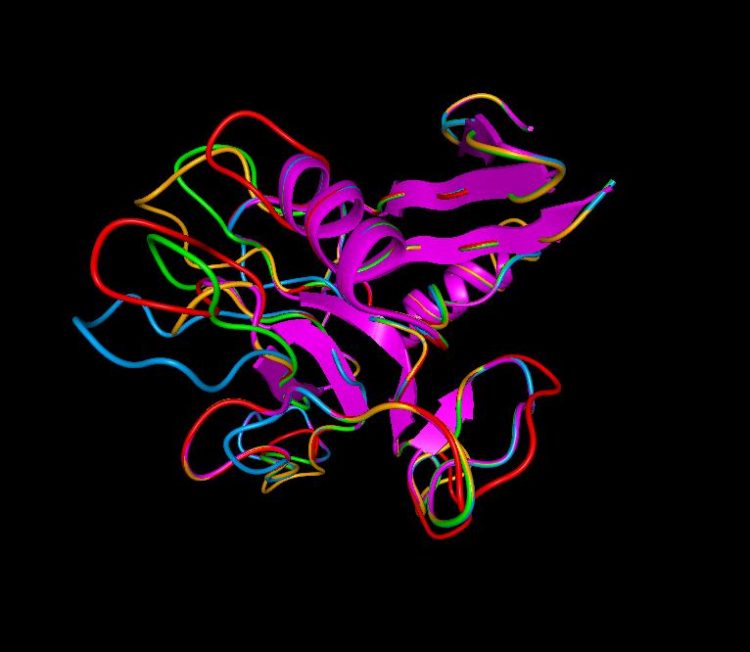Biotech materials made simple – crystal structures altered by a single protein

Perlucin has several characteristic protein strands, here indicated by colored loops in a BallView model. They are assumed to cause the observed structural alterations in calcium carbonate crystals. Copyright: INM; only free within this press release
Scientists in Haifa and Saarbrücken have now succeeded in replicating the combination of calcium carbonate and biopolymeric compounds which nature took millions of years and a host of environmental factors to achieve. Using a very simple method, they have been able to show that a single protein species is enough to produce specific effects on the formation of crystal structures.
The results of their research have recently been published as a cover publication in the journal Chemistry of Materials.
In nacre, layer lattices of inorganic calcium carbonate alternate with layers of organic material. Chitin, collagen and various proteins ensure that the calcium carbonate grows in these defined layers. What role the proteins play during growth had not previously been explained, but the assumption was that several proteins acted together to control the structure of the calcium carbonate lattice as well as themselves forming part of the nacreous layers.
However, Ingrid Weiss of the INM – Leibniz Institute for New Materials in Saarbrücken and her colleague Boaz Pokroy at the Technion Israel Institute of Technology have now shown that the crystal lattice of calcium carbonate can be altered using just a single protein species.
“This finding simplifies matters and opens up new possibilities for white biotechnology”, says Weiss, who is Head of the Biomineralization Program at the INM. “Until now, white biotechnology has labored under the idea that mineralization could not be recreated using biological models, because it was assumed that it took a combination of several proteins and a number of factors that were not readily understandable to make biomineralization possible”, she explains. If the natural processes appeared too complicated, they would not be pursued in industrial development.
Pokroy and Weiss have now proved that it need not be that complicated.
In their experiments, the researchers extracted the protein perlucin from abalone (Haliotis) shells and combined it with green fluorescent protein (GFP), a trick which enabled them to convert the insoluble perlucin to a water-soluble form. They added this solution at different concentrations to a calcium carbonate solution and examined the crystals produced. The results were compared to crystals produced from a pure calcium carbonate solution and crystals produced from a calcium carbonate solution with GFP.
Only the dissolved perlucin was incorporated in the inorganic carbonate lattice, where it produced notable and wide-ranging distortions to the lattice. The effect follows a principle of “all or nothing”: small quantities of protein are already enough to cause defined lattice distortions. Once the distortion starts, it then reproduces itself continually across the lattice. “GFP alone simply coexists with calcium carbonate – it surrounds the calcium carbonate lattice like a jacket without changing it”, explains the biomineralization expert. As in a shell, it seems to be the perlucin that influences the growth and structure of the crystal lattice.
To explain this phenomenon, the researchers used the INM’s expertise in mussel proteins and the expertise in crystal analysis at the Institute in Haifa. This combination made it possible to observe the reactions of perlucin in the crystal lattice. The scientists are now keen to see whether other proteins have specific effects on the structure and functionality of inorganic crystal lattices.
Original publication:
Eva Weber, Leonid Bloch, Christina Guth, Andy N. Fitch, Ingrid M. Weiss and Boaz Pokroy; Chem. Mater., 2014, 26 (17), pp 4925–4932,
DOI: 10.1021/cm500450s; http://pubs.acs.org/doi/abs/10.1021/cm500450s
Your experts:
Dr. Ingrid Weiss (PD)
INM – Leibniz Institute for New Materials
Head Biomineralization
Tel: 0681-9300-318
ingrid.weiss@inm-gmbh.de
Prof. Boaz Pokroy
Technion – Israel Institute of Technology; Haifa
Bio-Inspired Surface Engineering and Biomineralization
Phone: +972-4-8294584
bpokroy@tx.technion.ac.ilI
INM conducts research and development to create new materials – for today, tomorrow and beyond. Chemists, physicists, biologists, materials scientists and engineers team up to focus on these essential questions: Which material properties are new, how can they be investigated and how can they be tailored for industrial applications in the future? Four research thrusts determine the current developments at INM: New materials for energy application, new concepts for medical surfaces, new surface materials for tribological systems and nano safety and nano bio. Research at INM is performed in three fields: Nanocomposite Technology, Interface Materials, and Bio Interfaces.
INM – Leibniz Institute for New Materials, situated in Saarbrücken, is an internationally leading centre for materials research. It is an institute of the Leibniz Association and has about 195 employees.
Media Contact
More Information:
http://www.inm-gmbh.deAll latest news from the category: Materials Sciences
Materials management deals with the research, development, manufacturing and processing of raw and industrial materials. Key aspects here are biological and medical issues, which play an increasingly important role in this field.
innovations-report offers in-depth articles related to the development and application of materials and the structure and properties of new materials.
Newest articles

Superradiant atoms could push the boundaries of how precisely time can be measured
Superradiant atoms can help us measure time more precisely than ever. In a new study, researchers from the University of Copenhagen present a new method for measuring the time interval,…

Ion thermoelectric conversion devices for near room temperature
The electrode sheet of the thermoelectric device consists of ionic hydrogel, which is sandwiched between the electrodes to form, and the Prussian blue on the electrode undergoes a redox reaction…

Zap Energy achieves 37-million-degree temperatures in a compact device
New publication reports record electron temperatures for a small-scale, sheared-flow-stabilized Z-pinch fusion device. In the nine decades since humans first produced fusion reactions, only a few fusion technologies have demonstrated…





















